
ANIMAL-ASSISTED THERAPY (AAT) - WHAT IS IT?
ELRI HETTEMA
Assignment submitted as partial fulfillment of the requirements of the Masters of Arts degree
(Counselling Psychology) at the University of Stellenbosch
Supervisor: Prof T.W.B. van der Westhuysen

Stellenbosch University http://scholar.sun.ac.za
2
DECLARATION
I, the undersigned, hereby declare that the work contained in this assignment is my own original
work and that I have not previously in its entirety or in part submitted it at any University for a
degree.

Stellenbosch University http://scholar.sun.ac.za
Abstract
ANIMAL-ASSISTED THERAPY (AAT) - WHAT IS IT?
This study focuses on existing research into the field of animal-assisted therapy (AAT) and
attempts to provide a clear answer as to what animal-assisted therapy (AAT) is. In addition,
the limitations of current research, as well as future opportunities for research in this field and
some practical considerations for applying animal-assisted therapy are explored.
The origin of animal-assisted therapy is examined. How the present terminology has
developed in that it defines the use of animals in therapy as an adjunct to other therapeutic
techniques is discussed in contrast to previous terminology, which created the impression that
there was some form of managed process on the part of the animal. The terminology has
developed from terms such as pet therapy and pet-facilitated therapy to animal-assisted
therapy (AAT) and animal-assisted activities (AAA).
The history of animal-assisted therapy is examined in relation to the three therapy categories
of milieu therapy, physical rehabilitation and animal-assisted psychotherapy. The most
common theoretical frameworks for AAT are also discussed. In general, systems theory tends
to be the most favoured theoretical foundation for AAT.
The typical target populations of animal-assisted therapy are examined in the light of target
relationships. The six target relationships that a practitioner of animal-assisted therapy would
need to manage are identified and their merits discussed: therapist-and-patient relationship;
therapist-and-animal relationship; the staff-and-patient and staff-and-animal relationship; the
staff-and-animal therapist relationship; the animal-and-patient relationship; and the
application environment wherein these relationships are lived.
The typical research designs for AAT are also discussed within the history of AATand
successful research tends toward longitudinal studies wherein patients with similar diagnostic
profiles are all exposed to a common form of treatment. The experimental group has some
form of AAT in addition to the standard treatment whilst the control group continues with
only the standard treatment. Comparisons are made against specific measurements such as
degree of sociability and other indices. In general, the current research indicates a need for
research characterised by better controls and the application of general research principles to
supplement the abundance of anecdotal and case study reports on AAT.
In addition, the practical application of AAT is also examined in relation to training and
liability, office management and décor, animal well-being, and the necessary precautions to
safeguard patients from possible harm.
A critique of AAT is provided as well as the difficulties encountered in the practical
implementation of animal-assisted therapy. The literature reviewed for this study confirms
that animal-assisted therapy shows excellent promise, which increases when complimented
by experimental endeavour in terms of properly evaluated AAT programmes.
In terms of the future potential of AAT, the possible advantages of the implementation of
AAT programmes into schools, prisons and working environments is raised. Related
therapeutic adjuncts such as horticultural and natural therapy are also discussed. Fine (2000)
was the most up to date and encompassing source for AAT and may be a good tool to guide
future practitioners and researchers in the field of AAT.

Stellenbosch University http://scholar.sun.ac.za
Abstrak
DIERE-ONDERSTEUNDE TERAPIE (DOT) -WAT IS DIT?
Hierdie studie fokus op huidige navorsing op die gebied van diere-ondersteunde terapie
(DOT) en strewe om lig te gooi op wat presies diere-ondersteunde terapie is. Daarbenewens,
word die beperkinge van huidige navorsing sowel as toekomstige geleenthede vir navorsing
op hierdie gebied. Praktiese doelwitte vir die toepassing van diere-ondersteunde terapie is
ook geidentifiseer. Die oorsprong van diere-ondersteunde terapie word ondersoek. Hoe die
huidige terminologie ontwikkel het in sover dit die gebruik van diere aangaan in terapie as
adjunk tot ander terapeutiese tegnieke word bespreek, in vergelyking met vorige terminologie
wat die indruk geskep het dat daar een of ander bestuurde proses is wat deur die dier
uitgevoer word. Die terminologie het ontwikkel van terme soos troeteldierterapie en
troeteldier-gefasiliteerde terapie tot diere-ondersteunde terapie (DOT) en diere-
ondersteunde aktiwiteite (DOA).
Die geskiedenis van diere-ondersteunde terapie word ondersoek volgens die drie
terapiekategoriee van milieuterapie, fisiese rehabilitasie en diere-ondersteunde psigoterapie.
Die mees algemene teoretiese raamwerke vir DOT word ook bespreek. Oor die algemeen, is
sisteemteorie die sigbaarste teoretiese grondslag vir DOT.
Die tipiese teikengroepe vir diere-ondersteunde terapie word ondersoek in die lig van teiken
verhoudings. Die ses teikenverhoudings wat 'n praktisyn van diere-ondersteunde terapie sou
bestuur word onderskei en hul relatiewe meriete bespreek: die terapeut/pasient-verhouding;
terapeut/dier-verhouding; personeel/pasient-verhouding; personeel/diereterapeut- verhouding;
dier/pasient- verhouding ; sowel as die toepassings omgewing waarin die verhoudings
uitgeleef word.
Die tipiese navorsingsontwerpe vir DOT word ook binne die geskiedenis van DOT bespreek.
Die mees geloofwaardige navorsing neig tot longitudinale studies waarin pasiente met
soorgelyke diagnostiese profiele almal aan 'n gemene vorm van behandeling blootgestel is.
Die eksperimentele groep kry dan een of ander vorm van DOT sowel as die standaard
behandeling terwyl die kontrole groep slegs die standaard behandeling ontvang. Vergelykings
word dan gemaak volgens spesifieke metings soos mate van sosialiteit en ander persoonlike
effektiwiteit maatstawwe. Oor die algemeen dui huidige navorsing op 'n behoefte vir
navorsing wat deur beter beheer gekenmerk word, en die toepassing van algemene
navorsingsbegrippe om as aanvulling te dien tot die oorvloed anekdotiese en gevallestudies
wat die DOT literatuur betref. Daarbenewens word die die praktiese toepassing van DOT
ondersoek met betrekking tot opleiding en verantwoording, kantoorbeheer en dekor,
dierewelsyn sowel as die nodige teenmaatreëls om pasiente teen enige negatiewe gevolge te
beskerm.
'n Kritiese ontleding van DOT word ook voorsien en die moontlike struikelblokke wat in die
praktiese implementasie van diere-ondersteunde terapie ondervind kan word. Die literatuur
wat vir hierdie studie nagegaan is, bevestig dat diere-ondersteunde terapie uitstekende
vooruitsigte toon. Sover dit die toekomstige potensiaal van DOT aangaan, word die
moontlike voordele van die implementasie van DOT-programme in skole, tronke en
werksomgewings genoem. Verwante terapeutiese byvoegings soos tuin- en natuur-terapie
word ook bespreek. Fine (2000) blyk om die mees resente en omvattende bron van DOT te
wees en mag 'n goeie hulpmiddel wees om toekomstige praktisyns en navorsers op die
gebied van DOT van 'n riglyn te voorsien.

Stellenbosch University http://scholar.sun.ac.za
3
DEDICATIONS
Why did early man, when he expressed himself in rock engravings, choose animals as emblems of
his aspirations? Why have highly cultured races like the Egyptians and Assyrians used animals as
symbols for their Gods ... ? Why are we so deeply moved by tragedies involving our pets? Why are
the first toys given to our children representatives of animals? ...
Do we need more proof that we need animals more than they need us - that they can give us
something which we cannot give ourselves?
Joy Adamson - Pippa's Challenge
I would like to thank my husband Sean for all his support and my promoter Professor van der
Westhuysen for his patience.

Stellenbosch University http://scholar.sun.ac.za
TABLE OF CONTENTS
4
Page
1. INTRODUCTION, MOTIVATION FOR AND OBJECTIVES OF ASSIGNMENT
i.i. Introduction
5
1.2. Motivation for Assignment
5
1.3. Broad Objectives of Assignment
6
1.4. Delineation of Assignment
6
1.5. Terminology
7
1.6. Conclusion
8
2. ORIGIN OF ANIMAL-ASSISTED THERAPY (AAT)
8
3. OVERVIEW OF ANIMAL-ASSISTED THERAPY
3.l. Introduction
10
3.2. Therapy categories and disciplines associated with AA T
11
3.3. Most common theoretical frameworks associated with AAT
15
3.4. Typical target populations
16
3.5. Typical research and application designs
19
3.6. A developmental perspective on AAT
22
3.7. Related aspects
23
3.8. Critique of animal-assisted therapies
25
4. FUTURE POTENTIAL OF ANIMAL-ASSISTED THERAPY
26
5. REFERENCE LIST
28
7. RESOURCES
29

Stellenbosch University http://scholar.sun.ac.za
5
1. INTRODUCTION, MOTIVATION FOR AND OBJECTIVES OF ASSIGNMENT
1.1
Introduction
Levinson (1969, quoted in Brickel, 1986) highlighted the interconnectedness and co-
dependence of animals and humans over the ages. Humans have depended on
animals for food and protection from the elements. We have used animal hides for
clothing and shelters. Animals have also been used as a means of transport and as
extra muscle in labour such as ploughing fields. In return animals have had their
basic physical needs for food and shelter taken care of by humans. On a social and
emotional level this co-dependence has ranged from shared companionship between
human and animal such as the shepherd and his dog, .
The formal exploration of these human-animal interactions is an age-old endeavour
with advancing popular acceptance in the last 20 years, especially in terms of the
therapeutic application implications of these human-animal interactions. Available
resources vary in their knowledge contribution from the highly descriptive, almost
evangelistic studies of the converted to highly critical attacks on what is often
perceived as an emotionally laden area of study.
This assignment will strive to provide an answer as to precisely what animal-
assisted therapy (AAT) is.
1.2
Motivation for Assignment
In the process of exploring the field of animal-assisted therapy (AA T) it becomes
clear that there is a preponderance of hypothesis generating research. This research
is inclined to generate more empirical questions than confirming any specific
hypotheses. Mallon (1992) confirms that practitioners of animal-facilitated therapy
tend to report high levels of success based on case reports. These studies generally
report on the practical application of animal-assisted therapy within environments
such as prisons, nursing homes, homes for the disabled and in child care settings.
These practitioners according to Mallon (1992) typically do not focus sufficient
attention on scientific rigour in the application of AA T. According to Voelker
(1995, quoted in Fine, 2000) it is for this reason often difficult to obtain outcome
data in terms of animal-assisted therapy.

Stellenbosch University http://scholar.sun.ac.za
6
The motivation for this assignment is rooted in providing an integration of current
research and direct experience to clarify what exactly animal-assisted therapy is,
what it's limitations are and to highlight current research outcomes and future
research opportunities. Considerations to applying animal-assisted therapy will also
receive attention.
1.3
Broad Objectives of Assignment
The objectives of this assignment can be formulated as:
To clarify what animal-assisted therapy is;
To identify relevant considerations for the application of AAT as a therapeutic
adjunct;
To highlight the future potential of animal-assisted therapy;
and
To provide a summary of current animal-assisted therapy research.
1.4
Delineation of Assignment
To achieve the objectives in section 1.3 the assignment will examine the following
aspects of animal-assisted therapy:
The origin of animal-assisted therapy;
An overview of animal-assisted therapy;
Practical examples of, and considerations for, the systematic application of
animal-assisted therapy;
Research foundations of animal-assisted therapy; and
The future potential of animal-assisted therapy.
Odendaal (1992) maintains that there are primarily two motivations for applied
human-animal interaction. The first is to elicit emotional advantages and the second
is the utility value to humankind. The latter includes working animals, security
animals and sport and recreation. This study, however, will focus on the emotional
and physical value gained by human-animal interactions within the above fields. In
other words, the use of human-animal interactions that focuses on the therapeutic, as
opposed to utility, outcomes. The professions involved with the emotional value of
AAT include psychologists, social workers, educators, physiotherapists and
occupational therapists.

Stellenbosch University http://scholar.sun.ac.za
7
According to Brickel (1986) the field of animal-assisted therapy encompasses three
therapeutic categories: milieu therapy, physical rehabilitation and animal-facilitated
psychotherapy. This assignment is aimed at all three of the above categories.
1.5
Terminology
An abundance of AAT literature exists, as is apparent from the report by Draper,
Gerber and Layng (1990) indicating over a thousand references to animal-assisted
therapy in the current literature base. Furthermore they have indicated a diversified
use of terminology in AAT, although they ascribe the highest prevalence to the
following terms in the literature: Pet therapy, Pet Assisted Therapy and Pet
Facilitated Therapy. Draper et al. (1990) also point out that this trend to diversified
terminology confuses the field of study.
Mallon (1992) confirms a redefinition of all of the above to the more inclusive term
of animal-facilitated therapy. The use of the word "animal" is more encompassing
than "pet" as some therapies use animals that would not generally be construed as
pets. Furthermore the use of the word "facilitated" is more descriptive of the general
approach within most of the successful therapies described in the literature.
Fine (2000) chooses the term animal-assisted therapy, which seems to solve the
problem that animal-facilitated appears to denote a form of managed process on the
part of the animal. Animal-facilitated therapy could be interpreted as implying that
the animal facilitates the therapeutic process, denying the fact that it actually is
therapist that facilitates the process. Animal-assisted therapy is clearer in defining
the use of animals in therapy as an adjunct to other therapeutic techniques and
distinguishes between the use of an animal as an assistance to therapy and an
animal-directed form of therapy. The term animal-assisted therapy (AAT) will be
used as the standard for the purpose of this assignment.
Animal-assisted therapy as such is not a therapy modality in and of itself but rather a
particular therapeutic adjunct, which can be quite broadly applied.
According to Brickel (1986), animal-assisted therapy " ...refers to integrating
animals into client-directed therapeutic activities" (p 309).

Stellenbosch University http://scholar.sun.ac.za
8
1.6
Conclusion
Building on the above, the subsequent chapters will examine the origin and history
of animal-assisted therapy, the disciplines, theoretical frameworks and target
populations typically associated with animal-assisted therapy and the various
application designs for animal-assisted therapies. Considerations for AA T practice
will also be examined.
The research foundations, critique and the future potential of AA T will conclude the
assignment.
2.
THE ORIGIN OF ANIMAL-ASSISTED THERAPY
Odendaal (1989) provides an excellent perspective on the origin of animal-assisted
therapy. In this article he describes the main contributors according to the time of
their impact on the field of study and their goals with animal-assisted therapy. All of
those mentioned report a high degree of success and are generally acclaimed as
pioneers in the field.
In summary Odendaal (1989) describes the origin as follows: The earliest recorded
instance of the formal use of animals in therapy was by Gheel in the 9th Century in
Belgium, whose form of therapy was known as "therapy naturelle". This approach
included, apart from animals, the use of other natural resources in therapy. Another
early pioneer was William Tuke (circa ] 792) of the York Retreat Hospital in
England where the therapeutic goal with the use of animals was to facilitate the
development of self-control for emotionally disturbed people by stimulating
responsibility. Odendaal (1992) also mentions the Bethal Institute in Germany,
which was established in 1867 and still uses animals today as an integral part of its
therapeutic programmes.
Among the more recent contributions Odendaal (1989) highlights the work of Boris
Levinson in the 1960' s, especially with children. Some of Levinson's goals with
animal-assisted therapy were based in the creation of a safe relationship between
children and animals, wherein the child is in the leading position. He also used
animals to help break down psychological barriers. According to Levinson the
interaction between child and animal provides safe opportunities to discuss the
behaviour of the child directly or to discuss the behaviour of the animal as an

Stellenbosch University http://scholar.sun.ac.za
9
analogy of other relationships the child may be in. In this way animals assisted in
the therapeutic process.
The ]970's, (Odendaal 1989), yielded the husband and wife team of Prof Samuel
Corson and Dr Elizabeth Corson of the Ohio University Hospital in the United
States. They used animals in a medical hospital setting and coined the terminology
"pet facilitated psychotherapy". Their goals were focused on improving non-verbal
communication, stimulating self-confidence, the development of a reality orientation
and to decrease dependence on psychotropic drugs.
Odendaal (1989) discusses another six international practitioners who contributed to
AAT between 1970-1989, the most noteworthy being Dr Aaron Katcher from the
University of Pennsylvania in the early 1980's. Katcher was of the opinion that
animal-facilitated therapies have the following benefits: relief from loneliness;
fulfillment of the need to nurture; provision of a stimulus to activity; provision of an
object for touch and safe attachment; and fulfillment of the need to feel secure.
One of the most highly developed centres for animal-assisted therapy is the Green
Chimneys Farm (http://pcnet.coml-gchimney/story).This facility was started in
1947 on a farm close to New York City and programmes range from shelter care,
residential treatment, adult services and group homes. Green Chimneys have a
Residential Treatment Center, Residential Treatment Facility, Special Education
Day School, Farm & Wildlife Conservation Center, Arbor House and an Outdoor
Education Center. Green Chimneys utilizes Animal-Assisted Activities (milieu
therapy), Animal-Assisted Therapy and Equine-Assisted Psychotherapy.
They have recently completed a $12 million dollar campus, which offers
certification and internship training in animal-assisted therapy across a broad field.
Beck (Fine, 2000) quotes a survey by Walter-Toews in 1993 of 150 selected U.S.
and 74 Canadian humane societies. The findings indicated that 46% of the U.S. and
66% of the Canadian programmes ran animal-assisted programs.

Stellenbosch University http://scholar.sun.ac.za
10
Referring to South Africa Odendaal (1989) mentions two noteworthy projects in the
field of animal-assisted therapy. At Witrand Care and Rehabilitation Centre for the
mentally retarded in Potchefstroom, a study was conducted using cage birds to help
patients in the normalising process, establish recognition of personal individuality
and to monitor any general improvements in patient behaviour, with reported
positive results. At the Avril Elizabeth Home for the mentally and physically
disabled in Germiston, animal-assisted therapy formed part of the general
therapeutic programme and was used in conjunction with other therapeutic
approaches. The home had their own animal therapy unit with animals ranging from
horses to ducks. The programme was closed down around 1995 due to complaints
from neighbours and staffing difficulties.
Pollsmoor prison in Cape Town, South Africa also has a programme (Huisgenoot, 7
December 2000) wherein selected prisoners are involved in breeding and raising
parakeets for re-sale into the community. According to Wikus Gresse, a director at
the Pollsmoor Prison, the prisoners involved in the programme are less aggressive,
more responsible and have also learned some small business skills as a result of the
programme.
An overview of animal-assisted therapy will be addressed in the next chapter.
3.
OVERVIEW OF ANIMAL-ASSISTED THERAPY
3.1.
Introduction
Although still a relatively new area of practice, animal-assisted therapy literature has
crystallized to the point where the therapy categories, theoretical frameworks, target
populations and research foundations can be broadly specified. This chapter will
encompass:
3.2 The therapy categories and theoretical frameworks associated with animal-
assisted therapy;
3.3 The typical target populations for animal-assisted therapy;
3.4 The typical research and application designs of animal-assisted therapy;
3.5 A critique of animal-assisted therapy;
3.6 A developmental perspective on AAT; and
3.7 Related aspects.

Stellenbosch University http://scholar.sun.ac.za
11
3.2
Therapy categories and disciplines associated with AAT
Three types of animal-assisted therapy, namely: milieu therapy, physical rehabilitation
and animal-assisted psychotherapy are generally accepted delineations within the study
area of animal-assisted therapy (Brickel, 1986).
3.2.1
Milieu Therapy
According to Brickel (1986) milieu therapy quite simply involves introducing an animal
into an environment where there will be contact between animal and patient or vice
versa. This is the most commonly used form of animal-assisted therapy. The implicit
hypothesis is that human-animal contact interactions are intrinsically therapeutic. This is
also the simplest intervention form and the most broadly applicable type of human-
animal intervention to introduce. It is also the form best suited for lay therapists.
Corson et al. (1977, in Fine, 2000) exposed patients who had not responded to any
traditional therapies to a pet visitation programme. By comparing the previously
ineffective therapies with the effect of animal-assisted therapy the patients served as
their own controls. The patients continued to receive the traditional therapies at the
same time that the visitation programme was introduced. The milieu therapy included
the following elements. Animals were introduced into the care centre in kennels, in the
wards and during bedside visits. Primarily dogs were utilized.
Analysis of the recorded sessions between patient, animal and handler indicated that
patients became less withdrawn and responded to a therapist's questions sooner and
more comprehensively.
Subjectively the patients appeared happier. This immediately visible impact of milieu
therapy coupled with the resourcing advantage of using trained volunteers from the
general public, has allowed this form of AAT to flourish worldwide. A further
advantage of milieu therapy lies in the institution not having an animal care
responsibility in addition to their human care responsibility. The care of animals places
an additional burden on staff, which can lead to the failure of AAT programmes. A
common concern is the spread of zoonotic diseases. By involving a veterinarian in the
management ofthe programme the threat of zoonotic diseases may be controlled.

3.2.2
Stellenbosch University http://scholar.sun.ac.za
12
Physical rehabilitation
Physical rehabilitation programmes (Brickel, 1986) typically involve patients in care-
giving activities such as grooming, cleaning, feeding or walking the animals as well as
the cleaning and/or maintenance of cages, aquariums and stables. This category may
often be a peripheral benefit of milieu therapy. The health value is deduced from the
gross and fine muscle movements required during care-giving activities as well as the
psychological value of the responsibility of caring for a particular animal. The
interaction with an animal may also serve as a focus for sounds and speech in that
patients may be encouraged to emulate animal sounds within the context of speech
therapy or function as a topic for conversation. This may include animal sounds such as
barking or attempts to describe animal antics or characteristics. An extension of AAT in
terms of physical rehabilitation is the use of service animals for people with disabilities
primarily in the home setting but also in the form of guide dogs in work and other social
settings.
Beck (in Fine, 2000) highlights some interesting research by Allen and Blascovich in
the area of service animals for the disabled. The study included a group of patients with
ambulatory motor impairment examining measures such as locus of control, self-esteem
and community integration in relation to the use of a service dog. A "waiting list
control" approach was used wherein patients were their own control group over a period
of time. Patients either received a service dog 1 month or 12 months after the study
began. The expected experimental variable was the time that a subject was exposed to a
service dog in relation to the measures provided by the questionnaires used.
The monthly mail back questionnaires to the entire group were used to evaluate locus of
control, self-esteem and community integration in the control group (those who had not
yet received a service dog) and the experimental group (those who had already had a
service dog for a measurable period of time). The results indicated that the experimental
group (patients who received their service dogs 1 month after the study began) faired far
better than the control group (patients who received their service dogs up to 12 months
after the service began).
Based on the self-assessment of the participants those patients with a longer exposure
service dogs scored proportionally better for self-esteem, internal locus of control and

Stellenbosch University http://scholar.sun.ac.za
13
community integration. This group required fewer services, which resulted in savings of
more than R400,OOO per dog.
Thus physiotherapists, occupational therapists and speech therapists may find animal-
assisted therapy in this form able to contribute to some of their specific outcomes
(Brickel, 1986), such as improved self-esteem, internal locus of control and community
integration.
Other forms of physical rehabilitation programmes include specialised programmes
such as equestrian programmes. It is important, according to Beck (in Fine, 2000), that
one distinguishes between equine-assisted psychotherapy and hippotherapy. Equine-
assisted psychotherapy activities, such as riding and vaulting, are designed to co-
ordinate with the overall psychotherapeutic treatment of the individual. Typical
therapeutic goals according to Beck (in Fine, 2000) are improving self-confidence,
social competence and other variables related to quality of life. The goal is not to learn
to ride per se.
Hippotherapy on the other hand is applied by trained physical and occupational
therapists to improve patients neuro-motor functioning using horses. An additional
advantage of these forms of therapy is the reported enjoyment derived by patients whilst
receiving treatment. Thus the use of animals in physical and mental rehabilitation is best
suited for qualified rehabilitation therapists across a broad field ranging from
physiotherapists and occupational therapists to speech therapists.
3.2.3
Animal-assisted psychotherapy
Animal-assisted psychotherapy (Brickel, 1986) refers to the use of an animal in goal
directed therapeutic programmes focused on psychological or social outcomes. Goal
directed therapy in this case refers to there being specific goals identified by the
therapist for the animal-assisted session. An example could be to improve the self-
confidence of the patient. It is the ability of animals to elicit responses from people that
the therapist can capitalise upon that is especially valuable according to Brickel (1986).
In this instance, the typical therapists would include social workers, psychologists and
accredited counselors.
Odendaal (1992) links the following psychosocial outcomes or goals to animal-assisted
psychotherapy: life satisfaction, happiness, quality of life, improved self-image/self-

Stellenbosch University http://scholar.sun.ac.za
14
acceptance, self-confidence and improved social functioning/communication skills.
Odendaal identifies quality of life as the most significant outcome of animal-assisted
psychotherapy based on his review of research in this area of study.
An example of animal-assisted psychotherapy is presented in the qualitative research by
Kogan, Granger, Fitchett, Helmer and Young (1999). Two male participants, labelled as
emotionally disturbed by school professionals, took part in this study. Kogan et al.
(1999) specified therapeutic goals and the evaluation thereof based on the participants'
history of diagnoses and treatment. Participant A was evaluated according to the
development of appropriate social skills among peers or adults and a decreased level of
distractibility or attention deficit. Participant B was evaluated based on the development
of age appropriate behaviours, social skills and an increased sense of personal control
and power. Each participant was exposed to weekly AAT sessions of 45-60 minutes.
These sessions were comprised of a rapport-building and then an animal
training/presentation planning time. The participants needed to train the animal they
were working with to perform certain actions. At the end of the process each participant
would demonstrate the actions or tricks they had trained their animal to perform and
also present their experience of the entire process. The rapport-building period provided
time for the animal-handler to talk through relevant topics as initiated by the participant
or raised by the school professional in consultation with the animal handler (Kogan et
al.,1999). The animal training and presentation planning time was very goal-focused in
terms of learning how to command the dog to perform certain routine actions such as
sit, stay and fetch. The final goal was a planned execution of a certain sequence of
actions by the dog combined with a presentation of what the experience meant for each
participant.
The data sources for this study by Kogan et al. (1999) included the ADD-H
Comprehensive Teacher Rating Scale (ACTeRS), observations of sessions by education
professionals, multi-rater coding of 3 video sessions staggered from initial, mid-point
and final session, monitoring of Individual Education Plans (IEP) and post-intervention
interviews with the participants. The findings reported both participants as having
improved on the majority of their goals after the AAT intervention. As such, Kogan et
al. (1999), concluded that AAT is a highly effective supplementary tool for
psychotherapists and special education teachers.

Stellenbosch University http://scholar.sun.ac.za
15
3.3
Most common AAT theoretical frameworks
Prochaska (1984) provides a clear defmition of a system as a set of elements or
relationship interaction points that have some form of a consistent relationship.
According to Prochaska (1984), the organization of systems suggest that when
consistent relationship patterns form between individual interaction points in the
system, a different entity is produced which is greater than the sum of the parts of the
original system.
According to Triebenbacher (in Fine, 2000), systems theory appears to offer an
appropriate theoretical foundation on which therapists, psychologists, social workers
and other mental health professionals can build on in the process of including AAT in
their treatment plans. Odendaal (2000) appears to support this view indicating that
intraspecies social systems are not necessarily closed systems but can be expanded to be
interspecies social systems in nature. Thus, with AAT the companion animal being used
can be viewed as a vital member of the human family or social system. As Odendaal
(2000) emphasizes, AAT is about achieving a mutually beneficial interaction between
people and animals characterized by equilibrium and mutuality.
According to Prochaska (1984), the interactional or relationship relevance of systems
resides in the propensity of systems to form boundaries between different systems and
their subsystems. These boundaries guide the relationship patterns within systems and
reflect the rules of interaction for systems.
The interaction with animals as part of an interspecies system results in the formation of
patterns and boundaries that may serve the following therapeutic functions according to
Fine (2000):
They provide a social lubricant within the therapy setting;
They assist with rapport building;
They act as a catalyst for emotions; and
They provide opportunities for role-modelling.
The nature of these boundaries reflects the character of the relationship interactions
between different subsystems within a system and between different systems.

Stellenbosch University http://scholar.sun.ac.za
16
3.4
Typical target populations of AA T
In a systems theory context the target populations could be reframed as target
relationships according to Daniel et al. (1986). This means that the therapist, patient,
staff, animal, as well as the application environment and the interactive effects of all of
these possible relationships need to be considered as a whole when applying animal-
assisted therapy.
Figure 1 displays graphically the three-dimensional pyramid of interactions between
living organisms, as presented by Daniel et al. (1986), and the inter-relatedness of these
four relationship interaction points.
PATIENT
STAFF
THERAPIST
APPLICATION
ENVIRONMENT
Figure 1: Three dimensional pyramid of interactions in AAT (Daniel et al., 1986)

Stellenbosch University http://scholar.sun.ac.za
17
The above model is based upon a practical implementation study of an AA T programme
at the Hudson View Nursing Home in New York. Based on this Daniel et al. (1986)
distinguish the six target relationships that a practitioner of animal-assisted therapy
would need to manage, namely A: - The therapist-and-patient relationship; B: - The
therapist-and-animal relationship; C: - The staff-and-patient and staff-and-animal
relationship; D: - The staff-and-animal therapist relationship; E: - The animal-and-
patient relationship; and F: - The application environment wherein these relationships
are lived.
The therapist-and-patient relationship is best developed, according to Daniel et al.
(1986), by therapists with formal training and experience in assisting the patient
population in question. In addition to this formal training, the target relationship also
requires potential therapists to have professional or paraprofessional experience in the
appropriate application environments prior to the addition of an animal as "co-therapist"
into the relationship network. In other words should the application environment be a
prison it would be more effective should the therapist already have worked in a similar
environment prior to the introduction of AAT as a therapeutic adjunct. In this way the
therapist will only have to deal with the impact of AAT and not their own adjustment to
this particular application environment.
According to Hart (in Fine, 2000) animal-assisted therapies predominate in institutional
settings such as care centres for the elderly; the physically and mentally disabled,
children and youth, prisons and rehabilitation centres.
The therapist-and-animal relationship entails the interaction between the therapist and
the "animal co-facilitator". According to Daniel et al. (1986) it is imperative that the
potential therapist must have adequate knowledge and skills regarding applied animal
behaviour and the appropriate animal training required. The type and breed of animal
used is critical. The personality and behaviour of a particular type or breed of animal
needs to suit the planned AAT application. Organisations such as Therapy Dogs
International (tdi@gti.net) provide certification programmes for both the
handler/therapist and the relevant animal. This typically entails ensuring that the
animals and handlers are suitably trained for AAT applications. Elements here include
the animals being trained in certain commands to make them more manageable,

Stellenbosch University http://scholar.sun.ac.za
18
socialising the animals to be comfortable in settings with many people and a high level
of activity. In terms of the handlers or therapists the training typically includes animal
behaviour and control as well as care of the animal.
In any environment that includes care staff the staff-patient and staff-animal relationship
determines the success the therapist, introducing the animal-assisted therapy, will
achieve. The primary focus according to Daniel et al. (1986) is on the real impact an
AAT programme has on the total work environment of the care staff and the critical
reinforcement the care staff need to provide for the AAT programme to succeed.
The staff-and-animal therapist relationship determines the staff-patient and staff-animal
relationship. The staff-and-animal therapist relationship requires of the animal therapist
to create a relationship of trust and openness with the care staff (Daniel et aL, 1986).
This entails the development of a sensitivity and responsiveness to care staff needs and
concerns so as to be able to generate the solutions required for addressing the staff-
patient and staff-animal relationship.
Nebbe (1991) also emphasises as a necessity the need to involve the administration staff
of the institution in the design and motivation for an animal-assisted therapy
programme.
The therapist will therefore need to invest time in a careful monitoring of staff feelings
and concerns and the facilitation ofa constant dialogue with care staff with the ultimate
aim of the care staff being partners in the intervention with patients. According to
Cecilia Tweedy, the Hudson View Social Services Director, "The outcome was less
work for each department and more alert patients" during the implementation of this
model at Hudson View Nursing Home (Daniel et al., 1986).
Using the Avril Elizabeth Home once again as an example, their programme ran into
trouble as staff were often additionally loaded with animal care work, which they did
not have the time or inclination for. Staff at the Avri! Elizabeth Home also resented
having to deal with the additional stress of residents mourning animals that had died. It
is of critical importance that should one have a residential programme of this kind, that
interested and trained animal care staff are clearly identified. Clearly this type of
programme requires its own dedicated staff. Furthermore an AAT programme should, if
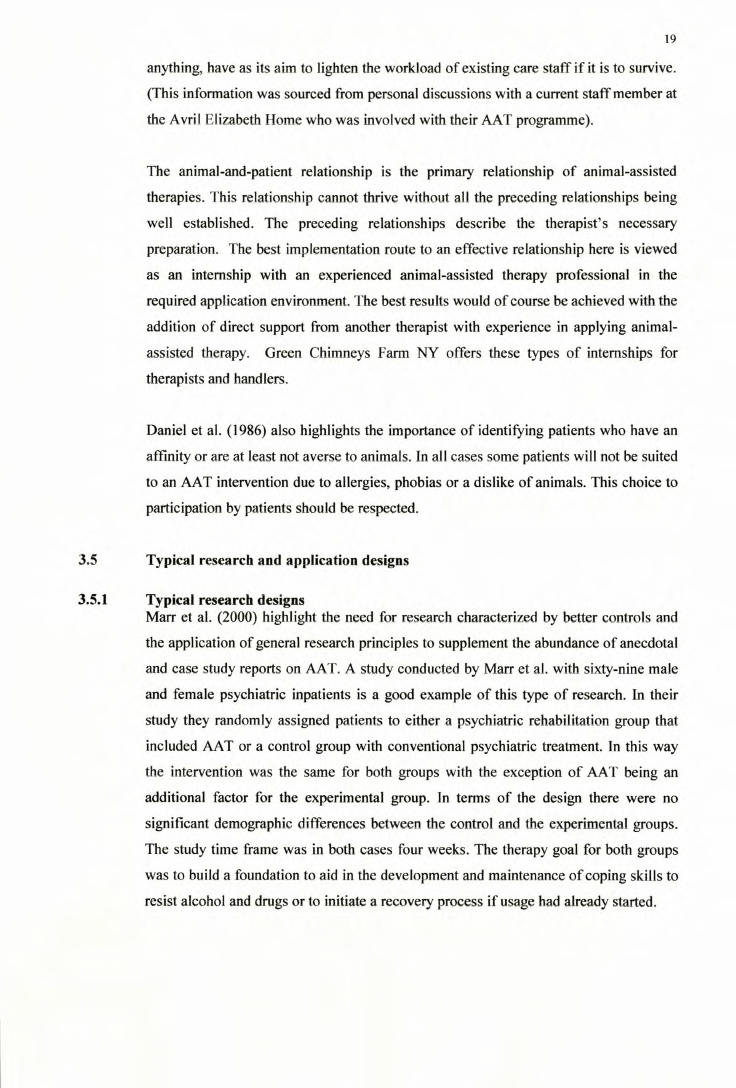
Stellenbosch University http://scholar.sun.ac.za
19
anything, have as its aim to lighten the workload of existing care staff if it is to survive.
(This information was sourced from personal discussions with a current staff member at
the Avril Elizabeth Home who was involved with their AAT programme).
The animal-and-patient relationship is the primary relationship of animal-assisted
therapies. This relationship cannot thrive without all the preceding relationships being
well established. The preceding relationships describe the therapist's necessary
preparation. The best implementation route to an effective relationship here is viewed
as an internship with an experienced animal-assisted therapy professional in the
required application environment. The best results would of course be achieved with the
addition of direct support from another therapist with experience in applying animal-
assisted therapy. Green Chimneys Farm NY offers these types of internships for
therapists and handlers.
Daniel et al. (1986) also highlights the importance of identifying patients who have an
affinity or are at least not averse to animals. In all cases some patients will not be suited
to an AAT intervention due to allergies, phobias or a dislike of animals. This choice to
participation by patients should be respected.
3.5
3.5.1
Typical research and application designs
Typical research designs
Marr et al. (2000) highlight the need for research characterized by better controls and
the application of general research principles to supplement the abundance of anecdotal
and case study reports on AAT. A study conducted by Marr et al. with sixty-nine male
and female psychiatric inpatients is a good example of this type of research. In their
study they randomly assigned patients to either a psychiatric rehabilitation group that
included AAT or a control group with conventional psychiatric treatment. In this way
the intervention was the same for both groups with the exception of AAT being an
additional factor for the experimental group. In terms of the design there were no
significant demographic differences between the control and the experimental groups.
The study time frame was in both cases four weeks. The therapy goal for both groups
was to build a foundation to aid in the development and maintenance of coping skills to
resist alcohol and drugs or to initiate a recovery process if usage had already started.
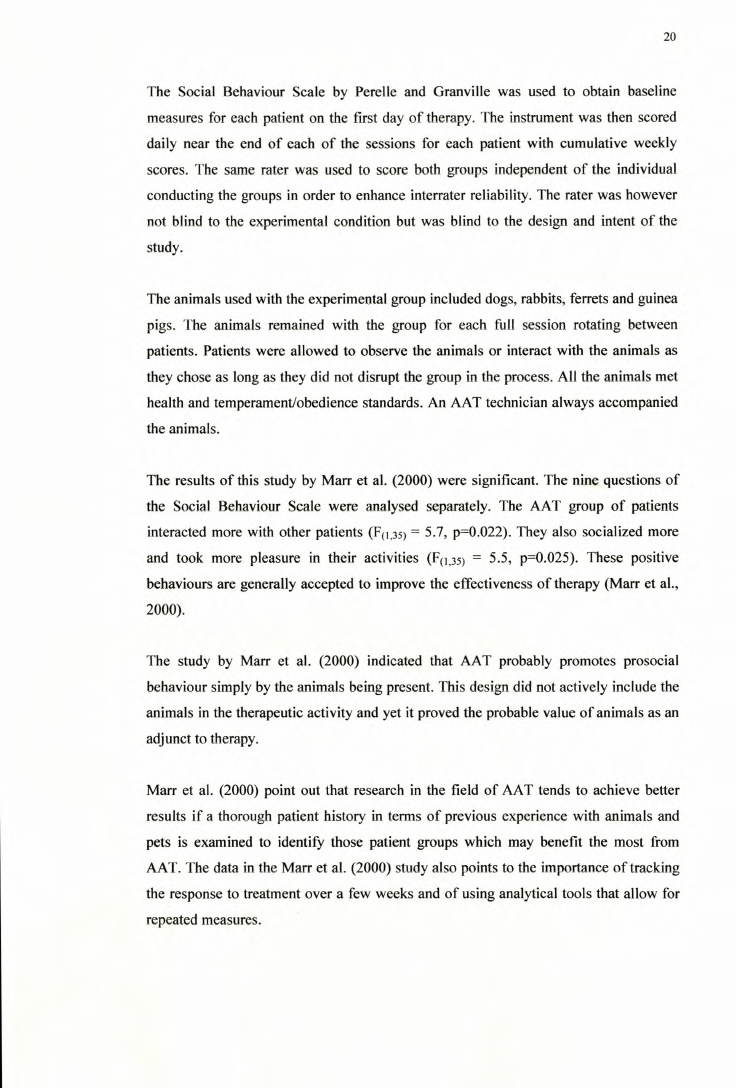
Stellenbosch University http://scholar.sun.ac.za
20
The Social Behaviour Scale by Perelle and Granville was used to obtain baseline
measures for each patient on the first day of therapy. The instrument was then scored
daily near the end of each of the sessions for each patient with cumulative weekly
scores. The same rater was used to score both groups independent of the individual
conducting the groups in order to enhance interrater reliability. The rater was however
not blind to the experimental condition but was blind to the design and intent of the
study.
The animals used with the experimental group included dogs, rabbits, ferrets and guinea
pigs. The animals remained with the group for each full session rotating between
patients. Patients were allowed to observe the animals or interact with the animals as
they chose as long as they did not disrupt the group in the process. All the animals met
health and temperament/obedience standards. An AAT technician always accompanied
the animals.
The results of this study by Marr et al. (2000) were significant. The nine questions of
the Social Behaviour Scale were analysed separately. The AAT group of patients
interacted more with other patients (F(l,35) = 5.7, p=0.022). They also socialized more
and took more pleasure in their activities (F(l,35) = 5.5, p=0.025). These positive
behaviours are generally accepted to improve the effectiveness of therapy (Marr et al.,
2000).
The study by Marr et al. (2000) indicated that AAT probably promotes prosocial
behaviour simply by the animals being present. This design did not actively include the
animals in the therapeutic activity and yet it proved the probable value of animals as an
adjunct to therapy.
Marr et al. (2000) point out that research in the field of AAT tends to achieve better
results if a thorough patient history in terms of previous experience with animals and
pets is examined to identity those patient groups which may benefit the most from
AAT. The data in the Marr et al. (2000) study also points to the importance of tracking
the response to treatment over a few weeks and of using analytical tools that allow for
repeated measures.
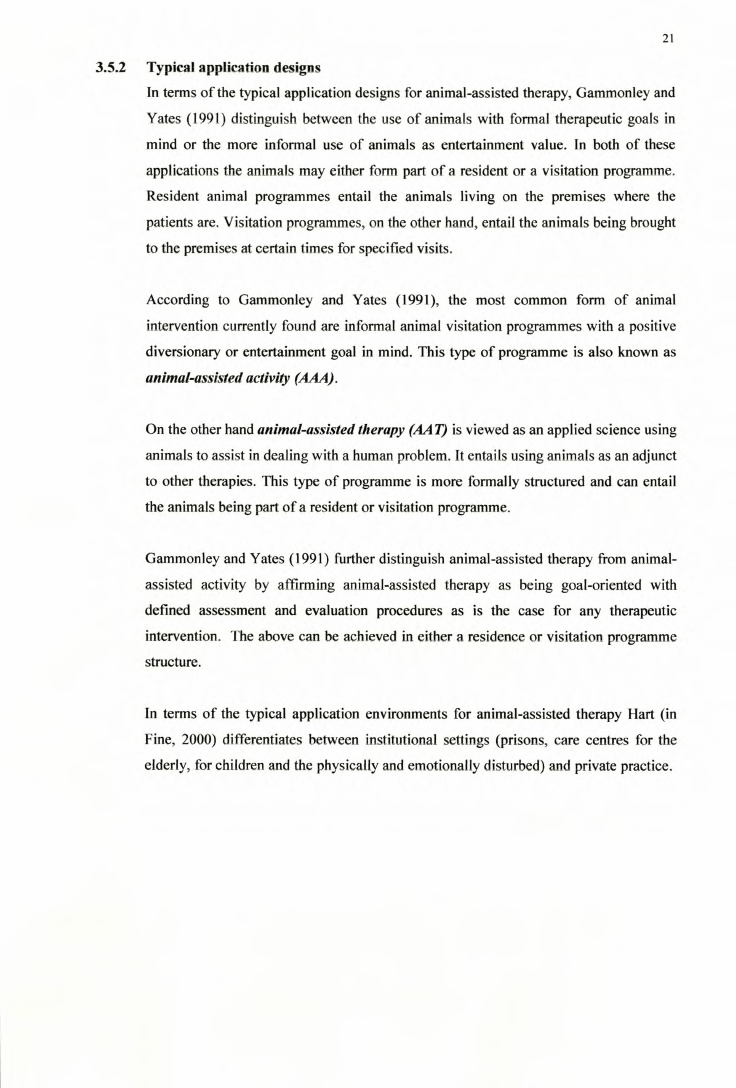
Stellenbosch University http://scholar.sun.ac.za
21
3.5.2
Typical application designs
In terms of the typical application designs for animal-assisted therapy, Gammonley and
Yates (1991) distinguish between the use of animals with formal therapeutic goals in
mind or the more informal use of animals as entertainment value. In both of these
applications the animals may either form part of a resident or a visitation programme.
Resident animal programmes entail the animals living on the premises where the
patients are. Visitation programmes, on the other hand, entail the animals being brought
to the premises at certain times for specified visits.
According to Gammonley and Yates (1991), the most common form of animal
intervention currently found are informal animal visitation programmes with a positive
diversionary or entertainment goal in mind. This type of programme is also known as
animal-assisted activity (AM).
On the other hand animal-assisted therapy (AA T) is viewed as an applied science using
animals to assist in dealing with a human problem. It entails using animals as an adjunct
to other therapies. This type of programme is more formally structured and can entail
the animals being part of a resident or visitation programme.
Gammonley and Yates (1991) further distinguish animal-assisted therapy from animal-
assisted activity by affirming animal-assisted therapy as being goal-oriented with
defined assessment and evaluation procedures as is the case for any therapeutic
intervention. The above can be achieved in either a residence or visitation programme
structure.
In terms of the typical application environments for animal-assisted therapy Hart (in
Fine, 2000) differentiates between institutional settings (prisons, care centres for the
elderly, for children and the physically and emotionally disturbed) and private practice.
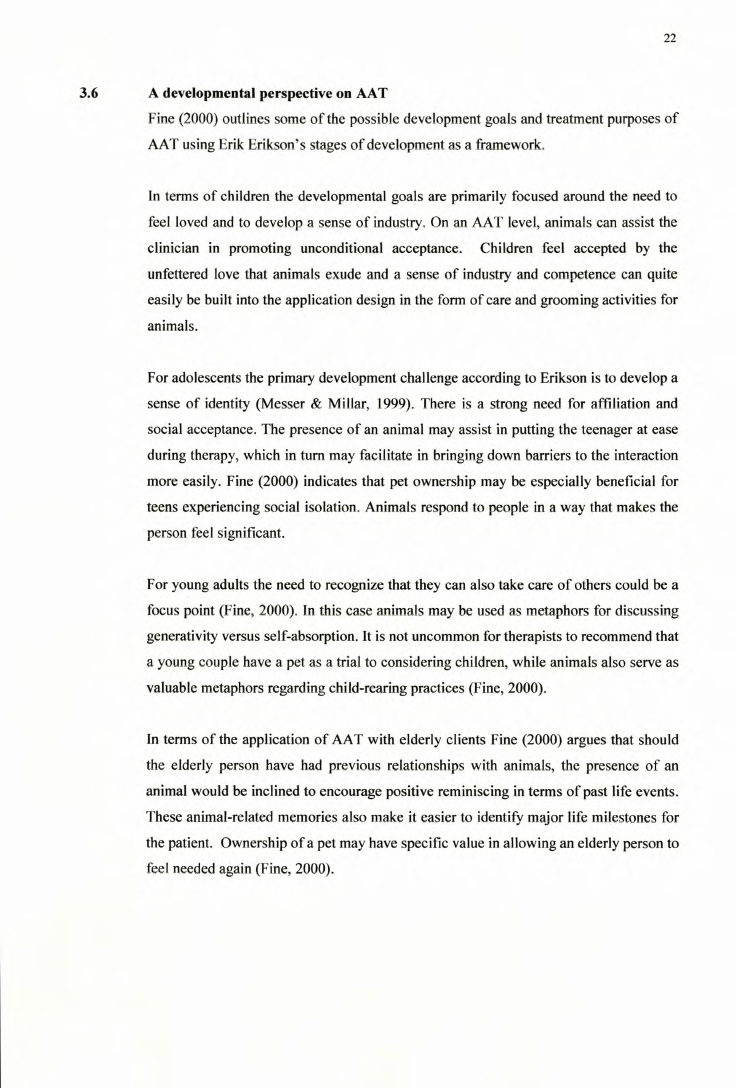
Stellenbosch University http://scholar.sun.ac.za
22
3.6
A developmental perspective on AAT
Fine (2000) outlines some of the possible development goals and treatment purposes of
AAT using Erik:Erikson's stages of development as a framework.
In terms of children the developmental goals are primarily focused around the need to
feel loved and to develop a sense of industry. On an AAT level, animals can assist the
clinician in promoting unconditional acceptance. Children feel accepted by the
unfettered love that animals exude and a sense of industry and competence can quite
easily be built into the application design in the form of care and grooming activities for
animals.
For adolescents the primary development challenge according to Erikson is to develop a
sense of identity (Messer & Millar, 1999). There is a strong need for affiliation and
social acceptance. The presence of an animal may assist in putting the teenager at ease
during therapy, which in tum may facilitate in bringing down barriers to the interaction
more easily. Fine (2000) indicates that pet ownership may be especially beneficial for
teens experiencing social isolation, Animals respond to people in a way that makes the
person feel significant.
For young adults the need to recognize that they can also take care of others could be a
focus point (Fine, 2000). In this case animals may be used as metaphors for discussing
generativity versus self-absorption. It is not uncommon for therapists to recommend that
a young couple have a pet as a trial to considering children, while animals also serve as
valuable metaphors regarding child-rearing practices (Fine, 2000),
In terms of the application of AAT with elderly clients Fine (2000) argues that should
the elderly person have had previous relationships with animals, the presence of an
animal would be inclined to encourage positive reminiscing in terms of past life events.
These animal-related memories also make it easier to identify major life milestones for
the patient. Ownership of a pet may have specific value in allowing an elderly person to
feel needed again (Fine, 2000).
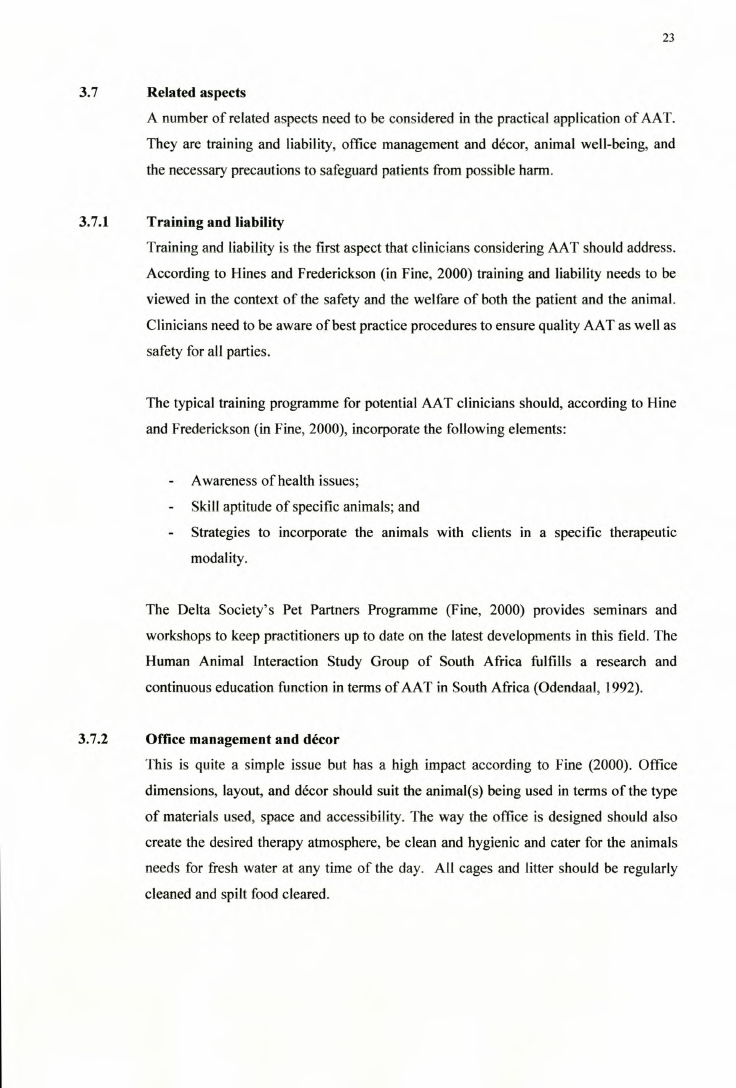
Stellenbosch University http://scholar.sun.ac.za
23
3.7
Related aspects
A number of related aspects need to be considered in the practical application of AAT.
They are training and liability, office management and décor, animal well-being, and
the necessary precautions to safeguard patients from possible harm.
3.7.1
Training and liability
Training and liability is the first aspect that clinicians considering AAT should address.
According to Hines and Frederickson (in Fine, 2000) training and liability needs to be
viewed in the context of the safety and the welfare of both the patient and the animal.
Clinicians need to be aware of best practice procedures to ensure quality AAT as well as
safety for all parties.
The typical training programme for potential AAT clinicians should, according to Hine
and Frederickson (in Fine, 2000), incorporate the following elements:
Awareness of health issues;
Skill aptitude of specific animals; and
Strategies to incorporate the animals with clients III a specific therapeutic
modality.
The Delta Society's Pet Partners Programme (Fine, 2000) provides seminars and
workshops to keep practitioners up to date on the latest developments in this field. The
Human Animal Interaction Study Group of South Africa fulfills a research and
continuous education function in terms of AAT in South Africa (Odendaal, 1992).
3.7.2
Office management and décor
This is quite a simple issue but has a high impact according to Fine (2000). Office
dimensions, layout, and décor should suit the animal(s) being used in terms of the type
of materials used, space and accessibility. The way the office is designed should also
create the desired therapy atmosphere, be clean and hygienic and cater for the animals
needs for fresh water at any time of the day. All cages and litter should be regularly
cleaned and spilt food cleared.
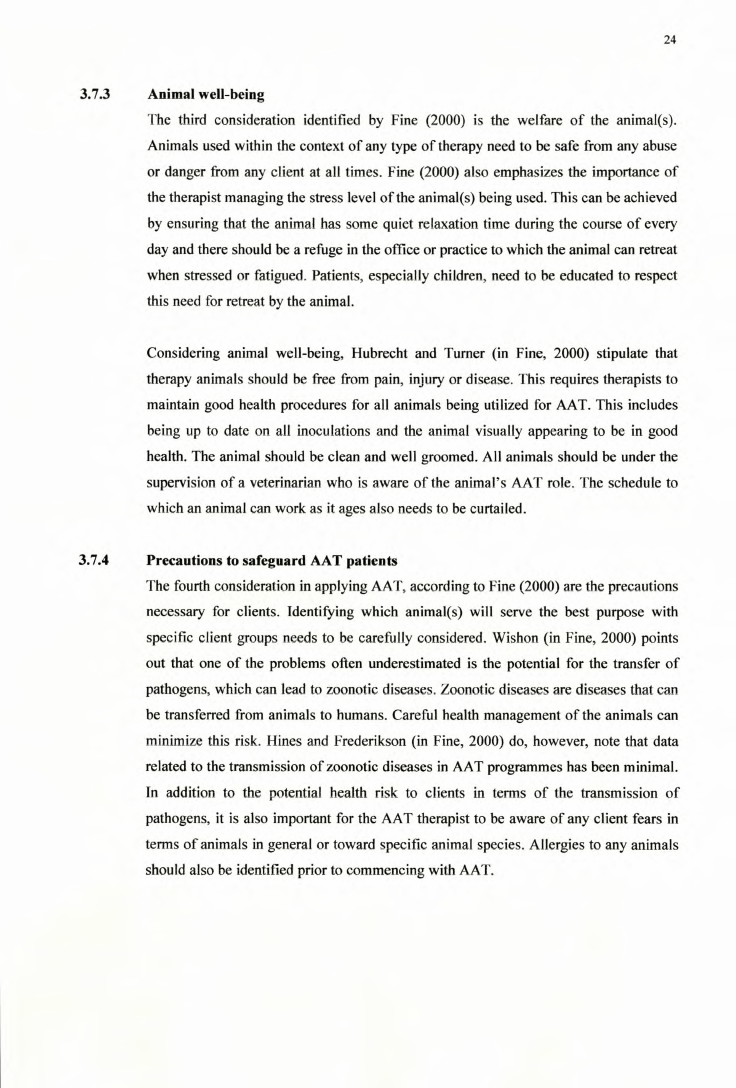
Stellenbosch University http://scholar.sun.ac.za
24
3.7.3
Animal well-being
The third consideration identified by Fine (2000) is the welfare of the animal(s).
Animals used within the context of any type of therapy need to be safe from any abuse
or danger from any client at all times. Fine (2000) also emphasizes the importance of
the therapist managing the stress level of the animal(s) being used. This can be achieved
by ensuring that the animal has some quiet relaxation time during the course of every
day and there should be a refuge in the office or practice to which the animal can retreat
when stressed or fatigued. Patients, especially children, need to be educated to respect
this need for retreat by the animal.
Considering animal well-being, Hubrecht and Turner (in Fine, 2000) stipulate that
therapy animals should be free from pain, injury or disease. This requires therapists to
maintain good health procedures for all animals being utilized for AAT. This includes
being up to date on all inoculations and the animal visually appearing to be in good
health. The animal should be clean and well groomed. All animals should be under the
supervision of a veterinarian who is aware of the animal's AAT role. The schedule to
which an animal can work as it ages also needs to be curtailed.
3.7.4
Precautions to safeguard AAT patients
The fourth consideration in applying AAT, according to Fine (2000) are the precautions
necessary for clients. Identifying which animal(s) will serve the best purpose with
specific client groups needs to be carefully considered. Wishon (in Fine, 2000) points
out that one of the problems often underestimated is the potential for the transfer of
pathogens, which can lead to zoonotic diseases. Zoonotic diseases are diseases that can
be transferred from animals to humans. Careful health management of the animals can
minimize this risk. Hines and Frederikson (in Fine, 2000) do, however, note that data
related to the transmission of zoonotic diseases in AAT programmes has been minimal.
In addition to the potential health risk to clients in terms of the transmission of
pathogens, it is also important for the AAT therapist to be aware of any client fears in
terms of animals in general or toward specific animal species. Allergies to any animals
should also be identified prior to commencing with AAT.
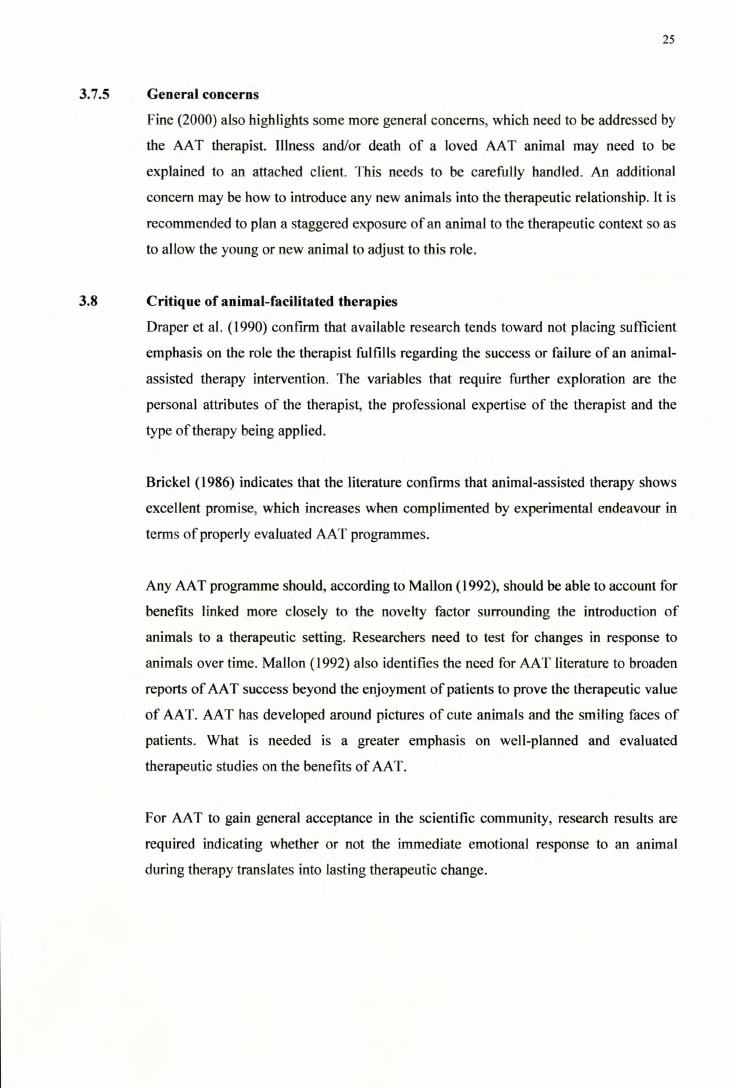
Stellenbosch University http://scholar.sun.ac.za
25
3.7.5
General concerns
Fine (2000) also highlights some more general concerns, which need to be addressed by
the AAT therapist. Illness and/or death of a loved AAT animal may need to be
explained to an attached client. This needs to be carefully handled. An additional
concern may be how to introduce any new animals into the therapeutic relationship. It is
recommended to plan a staggered exposure of an animal to the therapeutic context so as
to allow the young or new animal to adjust to this role.
3.8
Critique of animal-facilitated therapies
Draper et al. (1990) confirm that available research tends toward not placing sufficient
emphasis on the role the therapist fulfills regarding the success or failure of an animal-
assisted therapy intervention. The variables that require further exploration are the
personal attributes of the therapist, the professional expertise of the therapist and the
type of therapy being applied.
Brickel (1986) indicates that the literature confirms that animal-assisted therapy shows
excellent promise; which increases when complimented by experimental endeavour in
terms of properly evaluated AAT programmes.
Any AAT programme should, according to Mallon (1992), should be able to account for
benefits linked more closely to the novelty factor surrounding the introduction of
animals to a therapeutic setting. Researchers need to test for changes in response to
animals over time. Mallon (1992) also identifies the need for AAT literature to broaden
reports of AAT success beyond the enjoyment of patients to prove the therapeutic value
of AAT. AAT has developed around pictures of cute animals and the smiling faces of
patients. What is needed is a greater emphasis on well-planned and evaluated
therapeutic studies on the benefits of AAT.
For AAT to gain general acceptance in the scientific community, research results are
required indicating whether or not the immediate emotional response to an animal
during therapy translates into lasting therapeutic change.
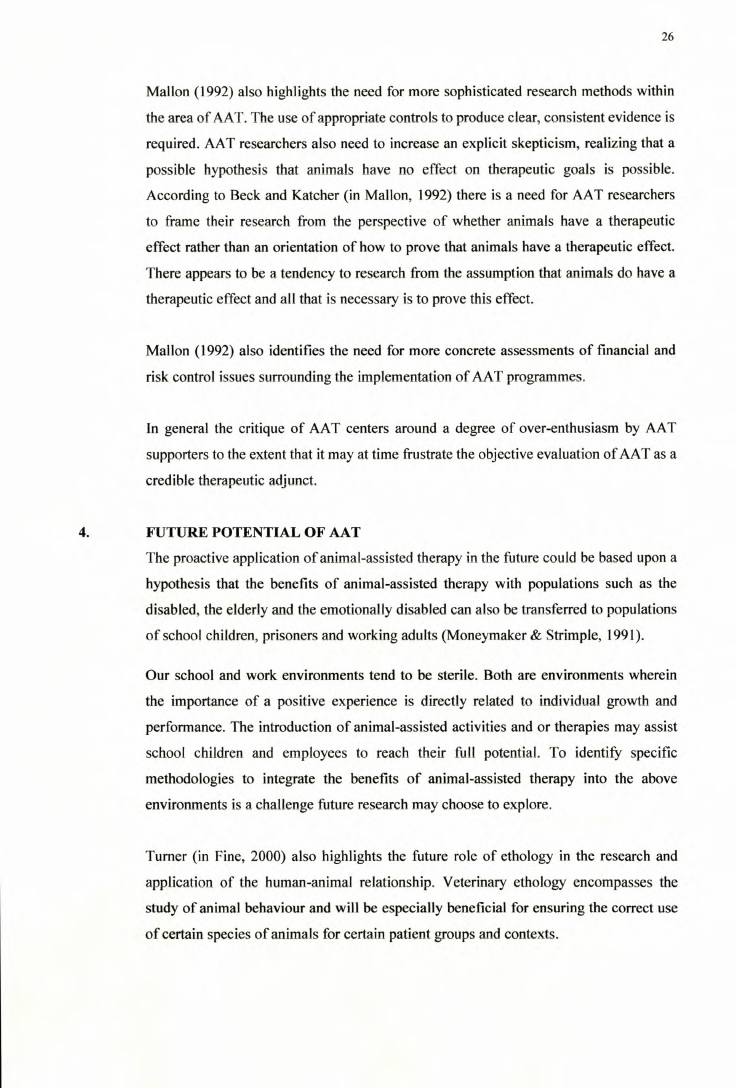
Stellenbosch University http://scholar.sun.ac.za
26
Mallon (1992) also highlights the need for more sophisticated research methods within
the area of AAT. The use of appropriate controls to produce clear, consistent evidence is
required. AAT researchers also need to increase an explicit skepticism, realizing that a
possible hypothesis that animals have no effect on therapeutic goals is possible.
According to Beck and Katcher (in Mallon, 1992) there is a need for AAT researchers
to frame their research from the perspective of whether animals have a therapeutic
effect rather than an orientation of how to prove that animals have a therapeutic effect.
There appears to be a tendency to research from the assumption that animals do have a
therapeutic effect and all that is necessary is to prove this effect.
Mallon (1992) also identifies the need for more concrete assessments of financial and
risk control issues surrounding the implementation of AAT programmes.
In general the critique of AAT centers around a degree of over-enthusiasm by AAT
supporters to the extent that it may at time frustrate the objective evaluation of AAT as a
credible therapeutic adjunct.
4.
FUTURE POTENTIAL OF AAT
The proactive application of animal-assisted therapy in the future could be based upon a
hypothesis that the benefits of animal-assisted therapy with populations such as the
disabled, the elderly and the emotionally disabled can also be transferred to populations
of school children, prisoners and working adults (Moneymaker & Strimple, 1991).
Our school and work environments tend to be sterile. Both are environments wherein
the importance of a positive experience is directly related to individual growth and
performance. The introduction of animal-assisted activities and or therapies may assist
school children and employees to reach their full potential. To identify specific
methodologies to integrate the benefits of animal-assisted therapy into the above
environments is a challenge future research may choose to explore.
Turner (in Fine, 2000) also highlights the future role of ethology in the research and
application of the human-animal relationship. Veterinary ethology encompasses the
study of animal behaviour and will be especially beneficial for ensuring the correct use
of certain species of animals for certain patient groups and contexts.
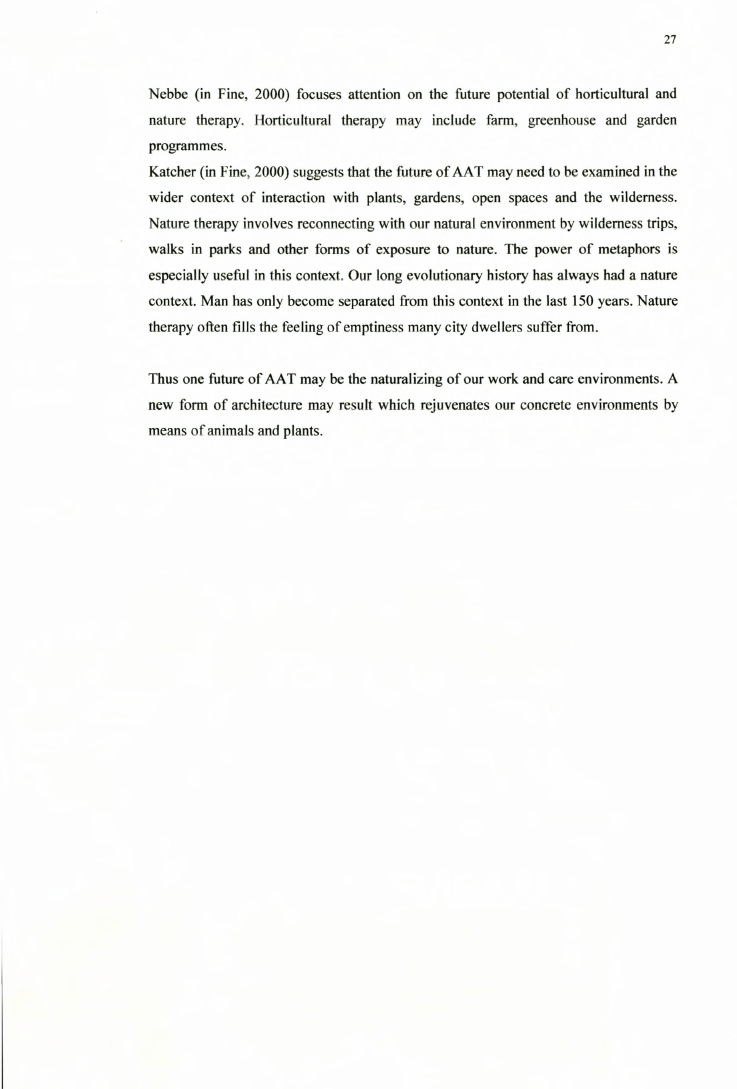
Stellenbosch University http://scholar.sun.ac.za
27
Nebbe (in Fine, 2000) focuses attention on the future potential of horticultural and
nature therapy. Horticultural therapy may include farm, greenhouse and garden
programmes.
Katcher (in Fine, 2000) suggests that the future of AAT may need to be examined in the
wider context of interaction with plants, gardens, open spaces and the wilderness.
Nature therapy involves reconnecting with our natural environment by wilderness trips,
walks in parks and other forms of exposure to nature. The power of metaphors is
especially useful in this context. Our long evolutionary history has always had a nature
context. Man has only become separated from this context in the last 150 years. Nature
therapy often fills the feeling of emptiness many city dwellers suffer from.
Thus one future of AAT may be the naturalizing of our work and care environments. A
new form of architecture may result which rejuvenates our concrete environments by
means of animals and plants.
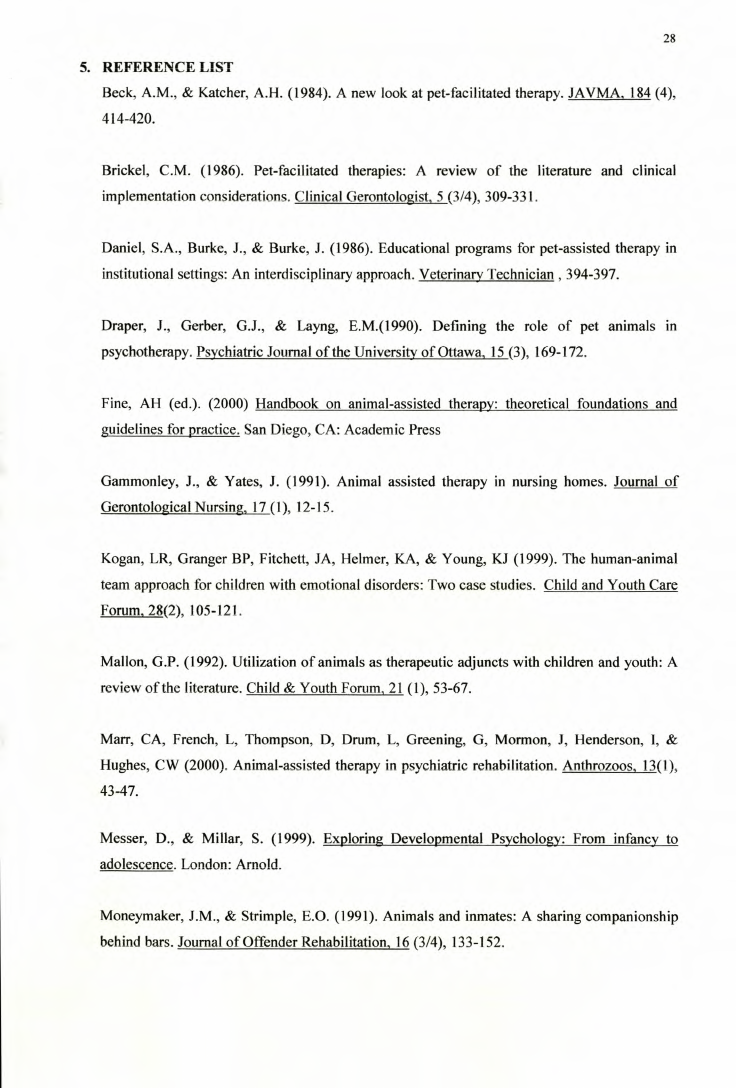
Stellenbosch University http://scholar.sun.ac.za
28
5. REFERENCE LIST
Beck, A.M., & Katcher, A.H. (1984). A new look at pet-facilitated therapy. JAVMA, 184 (4),
414-420.
Brickel, CM. (1986). Pet-facilitated therapies: A review of the literature and clinical
implementation considerations. Clinical Gerontologist,S (3/4), 309-331.
Daniel, S.A., Burke, J., & Burke, J. (1986). Educational programs for pet-assisted therapy in
institutional settings: An interdisciplinary approach. Veterinary Technician, 394-397.
Draper, J., Gerber, G.J., & Layng, E.M.(1990). Defining the role of pet animals in
psychotherapy. Psychiatric Journal of the University of Ottawa, 15 (3), 169-172.
Fine, AH (ed.). (2000) Handbook on animal-assisted therapy: theoretical foundations and
guidelines for practice. San Diego, CA: Academic Press
Gammonley, J., & Yates, J. (1991). Animal assisted therapy in nursing homes. Journal of
Gerontological Nursing, 17 (1),12-15.
Kogan, LR, Granger BP, Fitchett, JA, Helmer, KA, & Young, KJ (1999). The human-animal
team approach for children with emotional disorders: Two case studies. Child and Youth Care
Forum, 28(2), 105-121.
Mallon, G.P. (1992). Utilization of animals as therapeutic adjuncts with children and youth: A
review ofthe literature. Child & Youth Forum, 21 (1),53-67.
Marr, CA, French, L, Thompson, D, Drum, L, Greening, G, Mormon, J, Henderson, I, &
Hughes, CW (2000). Animal-assisted therapy in psychiatric rehabilitation. Anthrozoos, 13(1),
43-47.
Messer, D., & Millar, S. (1999). Exploring Developmental Psychology: From infancy to
adolescence. London: Arnold.
Moneymaker, J.M., & Strimple, E.O. (1991). Animals and inmates: A sharing companionship
behind bars. Journal of Offender Rehabilitation, 16 (3/4), 133-152.
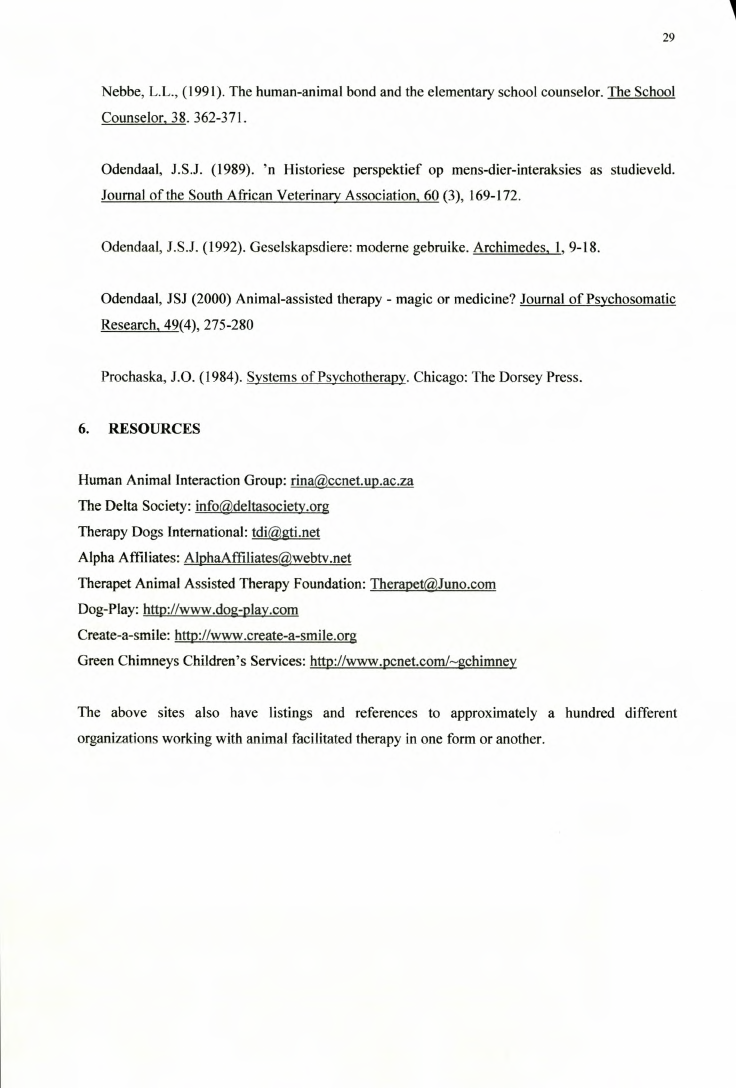
Stellenbosch University http://scholar.sun.ac.za
29
Nebbe, L.L., (1991). The human-animal bond and the elementary school counselor. The School
Counselor, 38. 362-371.
Odendaal, J.S.J. (1989). 'n Historiese perspektief op mens-dier-interaksies
Journal of the South African Veterinary Association, 60 (3), 169-172.
as studieveld.
Odendaal, J.S.l (1992). Geselskapsdiere: moderne gebruike. Archimedes, 1,9-18.
Odendaal, JSJ (2000) Animal-assisted therapy - magic or medicine? Journal of Psychosomatic
Research, 49(4), 275-280
Prochaska, J.O. (1984). Systems of Psychotherapy. Chicago: The Dorsey Press.
6. RESOURCES
Human Animal Interaction Group: rina@ccnet.up.ac.za
The Delta Society: info@deltasociety.org
Therapy Dogs International: tdi@gti.net
Alpha Affiliates: AlphaAffiliates@webtv.net
Therapet Animal Assisted Therapy Foundation: Therapet@Juno.com
Dog-Play: http://www.dog-play.com
Create-a-smile: http://www .create-a-smile.org
Green Chimneys Children's Services: http://www.pcnet.coml-gchimney
The above sites also have listings and references to approximately a hundred different
organizations working with animal facilitated therapy in one form or another.
